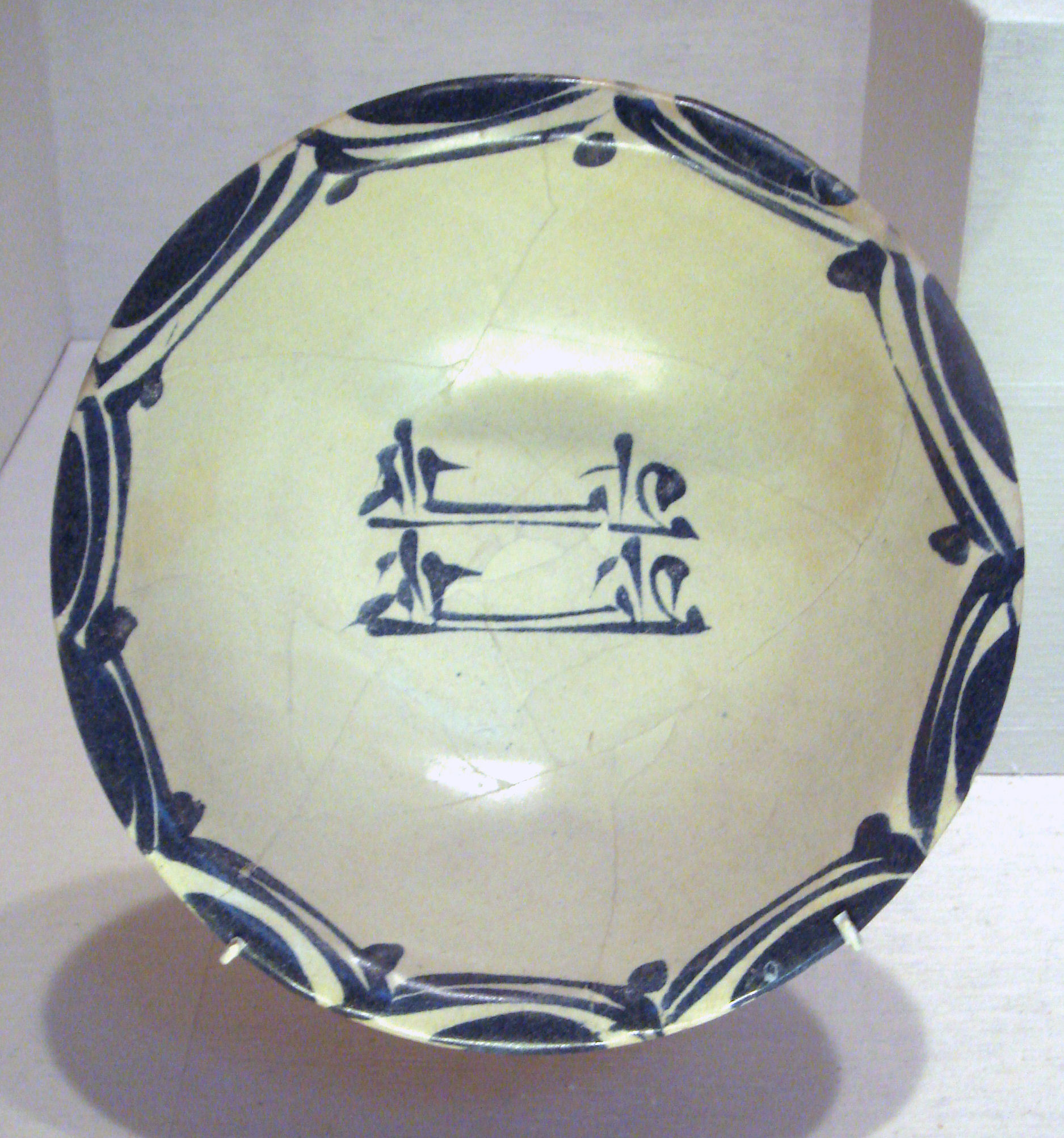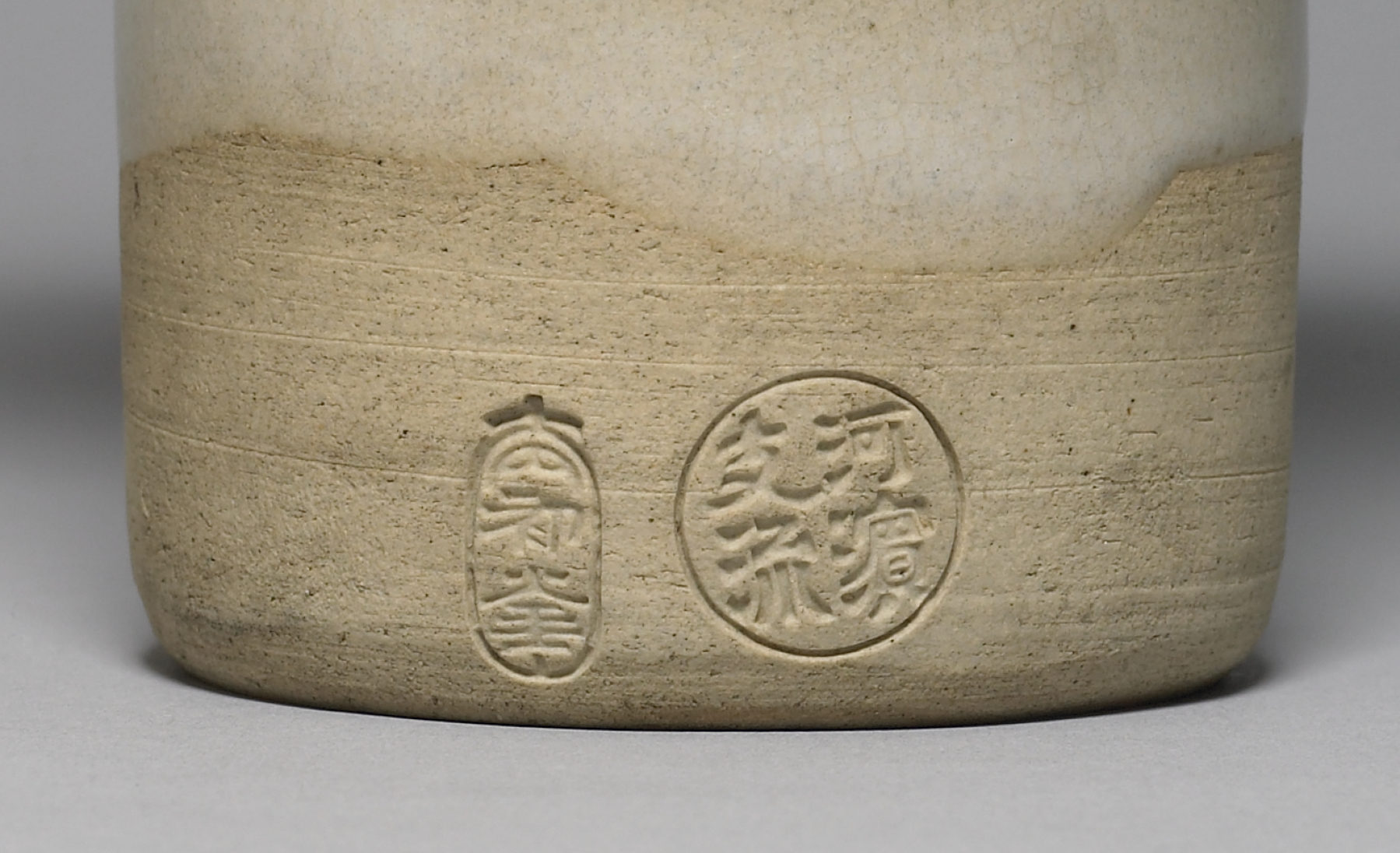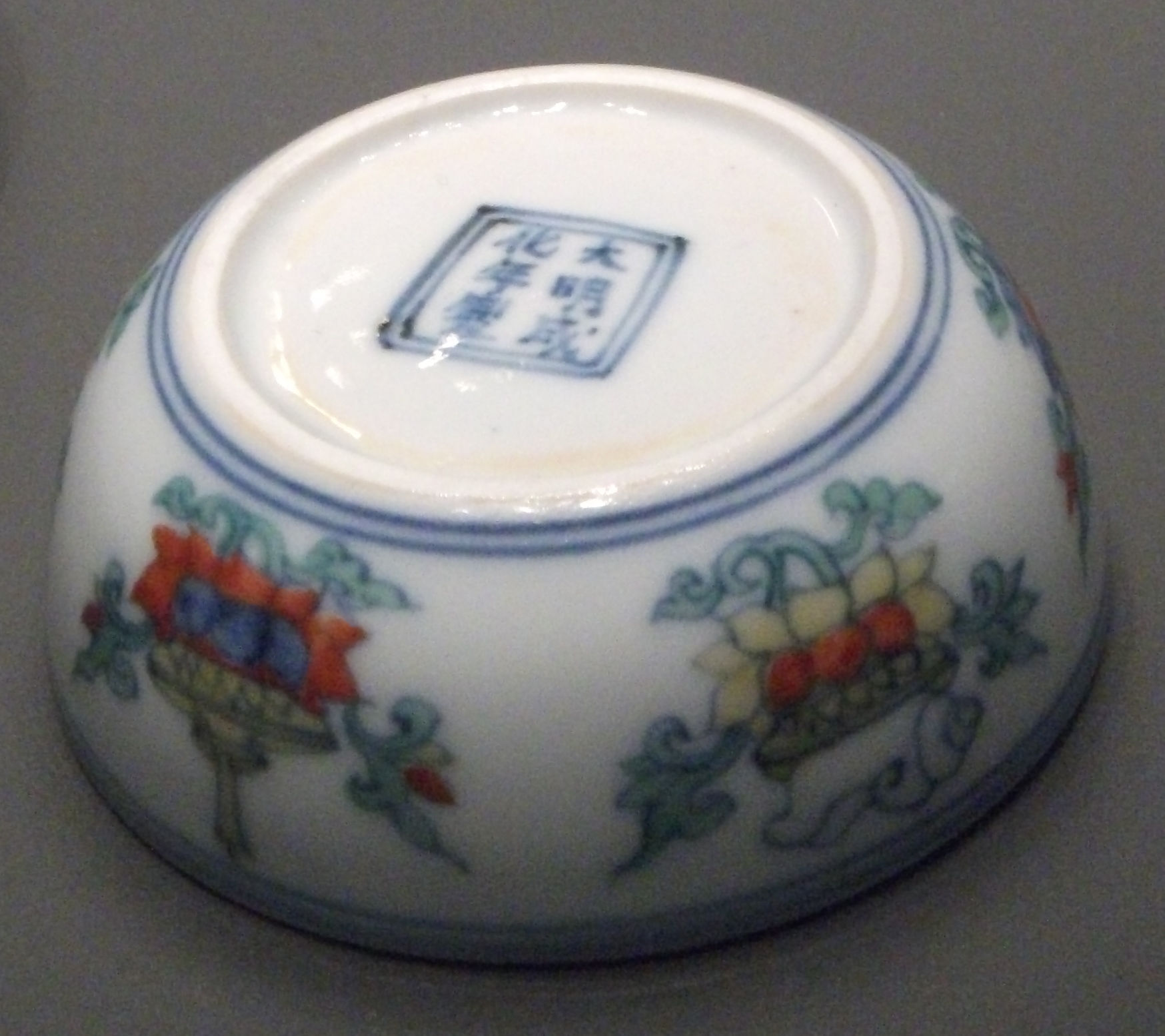|
Underglaze
Underglaze is a method of decorating pottery in which painted decoration is applied to the surface before it is covered with a transparent ceramic glaze and fired in a kiln. Because the glaze subsequently covers it, such decoration is completely durable, and it also allows the production of pottery with a surface that has a uniform sheen. Underglaze decoration uses pigments derived from oxides which fuse with the glaze when the piece is fired in a kiln. It is also a cheaper method, as only a single firing is needed, whereas overglaze decoration requires a second firing at a lower temperature. Many historical styles, for example Persian mina'i ware, Japanese Imari ware, Chinese doucai and wucai, combine the two types of decoration. In such cases the first firing for the body, underglaze decoration and glaze is followed by the second firing after the overglaze enamels have been applied. However, because the main or glost firing is at a higher temperature than used in overglaze deco ... [...More Info...] [...Related Items...] OR: [Wikipedia] [Google] [Baidu] |
China Painting
China painting, or porcelain painting, is the decoration of glazed porcelain objects such as plates, bowls, vases or statues. The body of the object may be hard-paste porcelain, developed in China in the 7th or 8th century, or soft-paste porcelain (often bone china), developed in 18th-century Europe. The broader term ceramic painting includes painted decoration on lead-glazed earthenware such as creamware or tin-glazed pottery such as maiolica or faience. Typically the body is first fired in a kiln to convert it into a hard porous biscuit or bisque. Underglaze decoration may then be applied, followed by glaze, which is fired so it bonds to the body. The glazed porcelain may then be painted with overglaze decoration and fired again to bond the paint with the glaze. Most pieces use only one of underglaze or overglaze painting, the latter often being referred to as "enamelled". Decorations may be applied by brush or by stenciling, transfer printing, lithography and screen pr ... [...More Info...] [...Related Items...] OR: [Wikipedia] [Google] [Baidu] |
İznik Pottery
Iznik pottery, or Iznik ware, named after the town of İznik in western Anatolia where it was made, is a decorated ceramic that was produced from the last quarter of the 15th century until the end of the 17th century. İznik was an established centre for the production of simple earthenware pottery with an underglaze decoration when, in the last quarter of the 15th century, craftsmen in the town began to manufacture high quality pottery with a fritware body painted with cobalt blue under a colourless transparent lead glaze. The designs combined traditional Ottoman arabesque patterns with Chinese elements. The change was almost certainly a result of active intervention and patronage by the recently established Ottoman court in Istanbul who greatly valued Chinese blue-and-white porcelain. During the 16th century the decoration of the pottery gradually changed in style, becoming looser and more flowing. Additional colours were introduced. Initially turquoise was combined with ... [...More Info...] [...Related Items...] OR: [Wikipedia] [Google] [Baidu] |
Blue And White Porcelain
"Blue and white pottery" () covers a wide range of white pottery and porcelain decorated under the glaze with a blue pigment, generally cobalt oxide. The decoration is commonly applied by hand, originally by brush painting, but nowadays by stencilling or by transfer-printing, though other methods of application have also been used. The cobalt pigment is one of the very few that can withstand the highest firing temperatures that are required, in particular for porcelain, which partly accounts for its long-lasting popularity. Historically, many other colours required overglaze decoration and then a second firing at a lower temperature to fix that. The origin of the blue glazes thought to lie in Iraq, when craftsmen in Basra sought to imitate imported white Chinese stoneware with their own tin-glazed, white pottery and added decorative motifs in blue glazes. Such Abbasid-era pieces have been found in present-day Iraq dating to the 9th century A.D., decades after the opening of a ... [...More Info...] [...Related Items...] OR: [Wikipedia] [Google] [Baidu] |
Blue And White Pottery
"Blue and white pottery" () covers a wide range of white pottery and porcelain decorated under the glaze with a blue pigment, generally cobalt oxide. The decoration is commonly applied by hand, originally by brush painting, but nowadays by stencilling or by transfer-printing, though other methods of application have also been used. The cobalt pigment is one of the very few that can withstand the highest firing temperatures that are required, in particular for porcelain, which partly accounts for its long-lasting popularity. Historically, many other colours required overglaze decoration and then a second firing at a lower temperature to fix that. The origin of the blue glazes thought to lie in Iraq, when craftsmen in Basra sought to imitate imported white Chinese stoneware with their own tin-glazed, white pottery and added decorative motifs in blue glazes. Such Abbasid-era pieces have been found in present-day Iraq dating to the 9th century A.D., decades after the openi ... [...More Info...] [...Related Items...] OR: [Wikipedia] [Google] [Baidu] |
Ceramic Glaze
Ceramic glaze is an impervious layer or coating of a vitreous substance which has been fused to a pottery body through firing. Glaze can serve to color, decorate or waterproof an item. Glazing renders earthenware vessels suitable for holding liquids, sealing the inherent porosity of unglazed biscuit earthenware. It also gives a tougher surface. Glaze is also used on stoneware and porcelain. In addition to their functionality, glazes can form a variety of surface finishes, including degrees of glossy or matte finish and color. Glazes may also enhance the underlying design or texture either unmodified or inscribed, carved or painted. Most pottery produced in recent centuries has been glazed, other than pieces in unglazed biscuit porcelain, terracotta, or some other types. Tiles are almost always glazed on the surface face, and modern architectural terracotta is very often glazed. Glazed brick is also common. Domestic sanitary ware is invariably glazed, as are many cera ... [...More Info...] [...Related Items...] OR: [Wikipedia] [Google] [Baidu] |
Ceramic Glaze
Ceramic glaze is an impervious layer or coating of a vitreous substance which has been fused to a pottery body through firing. Glaze can serve to color, decorate or waterproof an item. Glazing renders earthenware vessels suitable for holding liquids, sealing the inherent porosity of unglazed biscuit earthenware. It also gives a tougher surface. Glaze is also used on stoneware and porcelain. In addition to their functionality, glazes can form a variety of surface finishes, including degrees of glossy or matte finish and color. Glazes may also enhance the underlying design or texture either unmodified or inscribed, carved or painted. Most pottery produced in recent centuries has been glazed, other than pieces in unglazed biscuit porcelain, terracotta, or some other types. Tiles are almost always glazed on the surface face, and modern architectural terracotta is very often glazed. Glazed brick is also common. Domestic sanitary ware is invariably glazed, as are many cera ... [...More Info...] [...Related Items...] OR: [Wikipedia] [Google] [Baidu] |
Imari Ware
is a Western term for a brightly-coloured style of Japanese export porcelain made in the area of Arita, in the former Hizen Province, northwestern Kyūshū. They were exported to Europe in large quantities, especially between the second half of the 17th century and the first half of the 18th century. Typically Imari ware (in the English use of the term) is decorated in underglaze blue, with red, gold, black for outlines, and sometimes other colours, added in overglaze. In the most characteristic floral designs most of the surface is coloured, with "a tendency to overdecoration that leads to fussiness". The style was so successful that Chinese and European producers began to copy it. Sometimes the different overglaze styles of Kakiemon and Kutani ware are also grouped under Imari ware. The name derives from the port of Imari, Saga, from which they were shipped to Nagasaki, where the Dutch East India Company and the Chinese had trading outposts. In the West the multi-colour ... [...More Info...] [...Related Items...] OR: [Wikipedia] [Google] [Baidu] |
Wucai
''Wucai'' (五彩, "Five colours", "Wuts'ai" in Wade-Giles) is a style of decorating white Chinese porcelain in a limited range of colours. It normally uses underglaze cobalt blue for the design outline and some parts of the images, and overglaze enamels in red, green, and yellow for the rest of the designs. Parts of the design, and some outlines of the rest, are painted in underglaze blue, and the piece is then glazed and fired. The rest of the design is then added in the overglaze enamels of different colours and the piece fired again at a lower temperature of about 850°C to 900°C. It has its origins in the '' doucai'' technique. The usual distinction made with ''doucai'', which also combines underglaze blue with overglaze enamels in other colours, is that in ''wucai'' only parts of the design include blue, and these cover wider areas, and are often rather freely painted. In ''doucai'' the whole design is outlined in the blue, even if parts are overlaid by the enamels a ... [...More Info...] [...Related Items...] OR: [Wikipedia] [Google] [Baidu] |
Glost Firing
Ceramic glaze is an impervious layer or coating of a vitreous substance which has been fused to a pottery body through firing. Glaze can serve to color, decorate or waterproof an item. Glazing renders earthenware vessels suitable for holding liquids, sealing the inherent porosity of unglazed biscuit earthenware. It also gives a tougher surface. Glaze is also used on stoneware and porcelain. In addition to their functionality, glazes can form a variety of surface finishes, including degrees of glossy or matte finish and color. Glazes may also enhance the underlying design or texture either unmodified or inscribed, carved or painted. Most pottery produced in recent centuries has been glazed, other than pieces in unglazed biscuit porcelain, terracotta, or some other types. Tiles are almost always glazed on the surface face, and modern architectural terracotta is very often glazed. Glazed brick is also common. Domestic sanitary ware is invariably glazed, as are many ceramics us ... [...More Info...] [...Related Items...] OR: [Wikipedia] [Google] [Baidu] |
Doucai
''Doucai'' () is a technique in painting Chinese porcelain, where parts of the design, and some outlines of the rest, are painted in underglaze blue, and the piece is then glazed and fired. The rest of the design is then added in overglaze enamels of different colours and the piece fired again at a lower temperature of about 850°C to 900°C. The style began in the 15th century under the Ming dynasty in the imperial factories at Jingdezhen, and its finest products come from a few years in the reign of the Chenghua Emperor, mostly small pieces like the famous Chicken cups. The style was discontinued after a few decades, as a suitable overglaze blue was developed, but later revived under the Qing dynasty. It is not to be confused with the ''wucai'' style, which was a related early technique for polychrome painting. ''Doucai'' can be translated as "contrasted colours", "fitted colours", "colours which fit together" or "dove-tailed colours". The technique was driven by the restri ... [...More Info...] [...Related Items...] OR: [Wikipedia] [Google] [Baidu] |
Mina'i Ware
ware is a type of Persian pottery developed in Kashan, Iran, in the decades leading up to the Mongol invasion of Persia in 1219, after which production ceased. It has been described as "probably the most luxurious of all types of ceramic ware produced in the eastern Islamic lands during the medieval period". The ceramic body of white-ish fritware or stonepaste is fully decorated with detailed paintings using several colours, usually including figures. It is significant as the first pottery to use overglaze enamels, painted over the ceramic glaze fixed by a main glost firing; after painting the wares were given a second firing at a lower temperature. "" ( fa, مینایی), a term only used for these wares much later, means "enamelled" in the Persian language. The technique is also known as ''haft-rang'', "seven colours" in Persian. This was the term used by the near-contemporary writer Abu al-Qasim Kasani, who had a pottery background. This technique much later became th ... [...More Info...] [...Related Items...] OR: [Wikipedia] [Google] [Baidu] |
Overglaze Decoration
Overglaze decoration, overglaze enamelling or on-glaze decoration is a method of decorating pottery, most often porcelain, where the coloured decoration is applied on top of the already fired and glazed surface, and then fixed in a second firing at a relatively low temperature, often in a muffle kiln. It is often described as producing "enamelled" decoration. The colours fuse on to the glaze, so the decoration becomes durable. This decorative firing is usually done at a lower temperature which allows for a more varied and vivid palette of colours, using pigments which will not colour correctly at the high temperature necessary to fire the porcelain body. Historically, a relatively narrow range of colours could be achieved with underglaze decoration, where the coloured pattern is applied before glazing, notably the cobalt blue of blue and white porcelain. Many historical styles, for example mina'i ware, Imari ware, Chinese doucai and wucai, combine the two types of decorat ... [...More Info...] [...Related Items...] OR: [Wikipedia] [Google] [Baidu] |






.jpg)

.jpg)